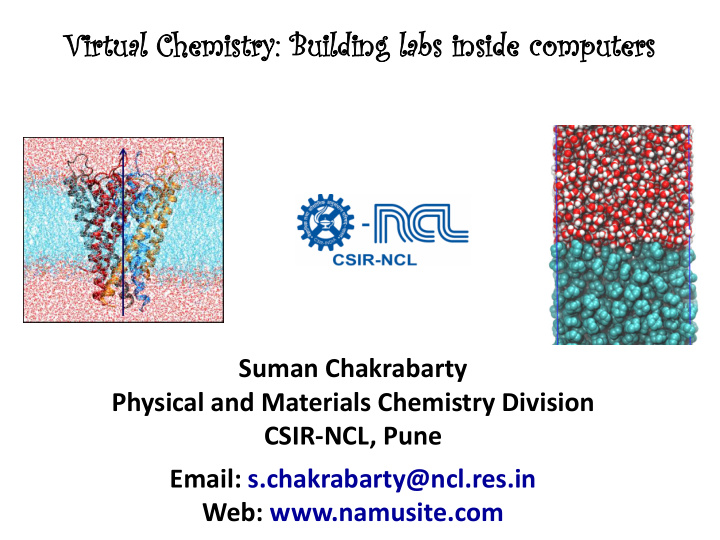



Virt irtual al Ch Chemis emistry: y: B Buil ildin ding labs abs in insid ide e comp mputers ers Suman Chakrabarty Physical and Materials Chemistry Division CSIR-NCL, Pune Email: s.chakrabarty@ncl.res.in Web: www.namusite.com
Visit us: http://academic.ncl.res.in/
Why “virtual chemistry”?!
Why “virtual chemistry”?! OR Cleaner Cheaper Easier (?) Cooler! ;)
Simplify! Remove Real Model unnecessary details System system Write equations Design and Use Lots of perform computers! maths! experiment Compare Compare Experimental “computer “analytical” data simulation” theory
Virtual Chemistry Lab (Ideally) Properties Input Methods Functions
How big/small we are? Video Clip: https://www.youtube.com/watch?v=EMLPJqeW78Q (The Smallest to the Biggest thing in the Universe!) (Find the Ted-Ed videos in Youtube: https://www.youtube.com/user/TEDEducation)
Why ice floats on water? … and why some things are solid or liquid or gas? Watch at home (TED-ED): https://www.youtube.com/watch?v=UukRgqzk-KE
Molecules talk to each other
Motion: potential energy vs. kinetic energy
Molecule: many balls and springs E total = E bonded + E non-bonded E bonded = E bond + E angle + … etc. E non-bonded = E VDW + E electrostatic +0.4 E VDW q q ∝ i j +0.4 -0.8 E elec r Opposite charges like each other
Molecular Dynamics == Newton’s Equation of Motion (i) Rate of change of (potential) energy == Force ∆ V = − ∆ F x Force = mass X (rate of change in velocity) Velocity = rate of change in position (ii) If we know position (and velocity) of all atoms at all times, we have the MOLECULAR MOVIE!!!!
Some examples: Gas chamber: hard spheres (a movie was shown in the talk)
Why ice floats on water? Movie of water freezing (Youtube)
Why oil and water don’t mix? … and how come salt/sugar dissolves so easily?! See this: https://www.youtube.com/watch?v=h5yIJXdItgo
Why oil and water don’t mix? First few moments of the life of a Salt (Sodium Chloride) crystal in water (300K) (370K) Oil and water put together (Some movies were shown in the actual talk)
Proteins: The workhorses of life Amino acids: The 20 building blocks of life
What about LARGE molecules with both salt-like and oil-like parts? White: non-polar: “oily” Green: polar: “watery” Red: negative charge: “salty” Blue: Positive charge: “salty”
Challenge: Protein Folding Problem Given the amino acid sequence, can you predict the natural folded structure? Lysozyme Porin Video clip: Protein folding Cytochrome c Oxidase https://www.youtube.com/watch?v=gFcp2Xpd29I
Designing new molecules: for better materials, better medicines How does your medicines (drug!) work? Let’s look into the “moleculoscope”: MD movie Watch at home: A basic introduction to drugs, drug targets, and molecular interactions (https://www.youtube.com/watch?v=u49k72rUdyc)
Voltage gated ion channels: How these things work?
Aquaporin: A molecular sieve Can we learn from aquaporins: The ultimate water purifier?
“on water” reactions Certain reactions happen many times faster at the oil-water surface!
Advantages of computer simulation: “Moleculoscope”: Molecular microscope to see their real-time motion Molecular view of nature connected to properties/functions Full control over molecular interactions and how they affect properties Setting up (or even execution) of “computer experiments” is easier and faster compared to labwork! Acceleration of rare events
Who can take the challenge? Jack of all trades: Chemistry, Physics, Mathematics, Biology, Computer Programming, Visualization … Love to play with computers (not just for Facebook!) Play with molecules and control them; Play God! Don’t just follow textbooks, question/extend them ; Don’t just follow, lead/innovate! … a final video clip!
“for the development of multi-scale models for complex chemical systems” Martin Karplus (83) Arieh Warshel (73) Michael Levitt (66) U.S. and Austrian citizen. Born U.S. and Israeli citizen. U.S., British and Israeli citizen. 1930 in Vienna, Austria. Ph.D. 1953 Born 1940 in Kibbutz Sde- Born 1947 in Pretoria, South from California Institute of Nahum, Israel. Ph.D. 1969 Africa. Ph.D. 1971 from University Technology, CA, USA. Professor from Weizmann Institute of Cambridge, UK. Robert W. and Conventionné, Université de of Science, Rehovot, Israel. Vivian K. Cahill Professor in Cancer Strasbourg, France and Theodore Distinguished Professor, Research, Stanford University William Richards Professor of University of Southern School of Medicine, Stanford, CA, Chemistry, Emeritus, Harvard California, Los Angeles, CA, USA. University, Cambridge, MA, USA. USA.
“Computers are incredibly fast, accurate and stupid. Human beings are incredibly slow, inaccurate and brilliant. Together they are powerful beyond imagination.” Happy computing! Caveat: Garbage in, garbage out!
Questions? Email: s.chakrabarty@ncl.res.in Web: www.namusite.com
Recommend
More recommend